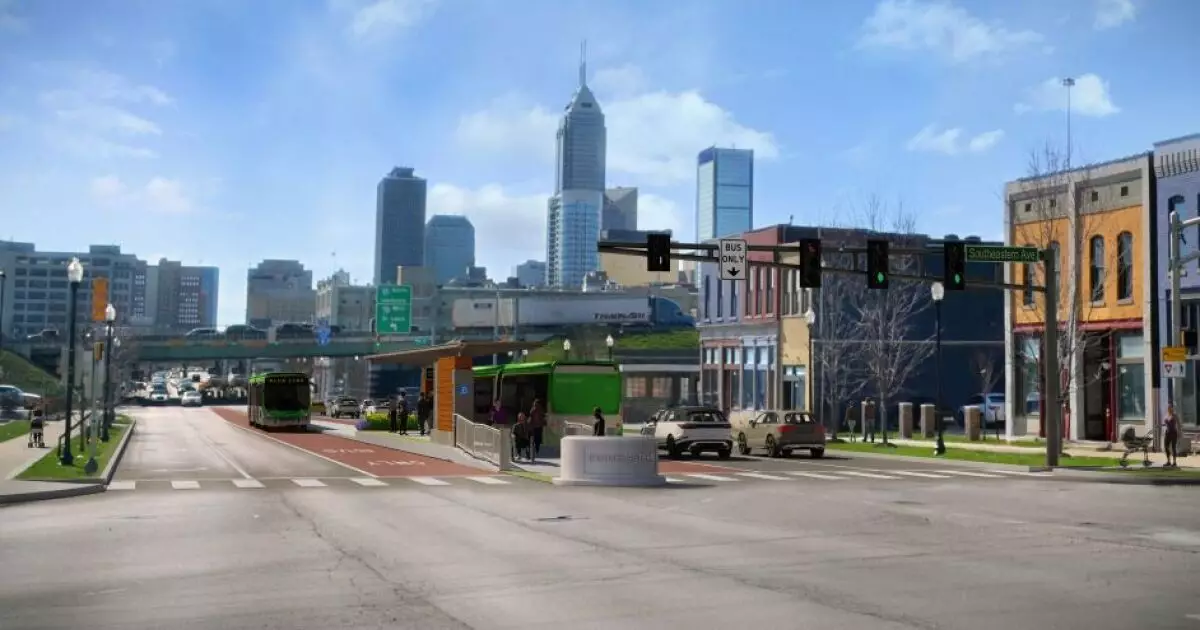125 Million Reasons Why IndyGo’s Bus Transit Expansion is a Risky Venture

In a rapidly evolving urban landscape, Indianapolis is making a move that many would view as groundbreaking: a $125 million bond sale aimed at funding the Blue Line Bus Rapid Transit (BRT) project. Stretching an impressive 24 miles from the Indianapolis International Airport to downtown and threading into the eastern edge of Marion County, this project promises efficiency for transit riders—an appealing prospect in the face of rising traffic congestion and the environmental toll of traditional commuting methods. However, beneath this shiny exterior lies a complicated web of financial risks and potential pitfalls that warrant critical scrutiny.
The intention behind the Blue Line BRT is clear—enhancing public transit to make it more comparable to the advantages of light rail. The bold move aligns with a broader trend many cities are adopting to cope with mounting urban density and the imperative for reduced carbon footprints. Yet, one question looms over this initiative: can Indianapolis afford this ambitious leap? With municipal bond yields on the rise and economic volatility on the horizon, local taxpayers may find themselves enmeshed in a costly venture that could bear significant consequences.
Understanding the Financial Framework
The financial structure of the $125 million bond sale is struggling under its own weight. While the bonds, rated AA-minus by S&P Global Ratings, promise stability, the decision to delay the pricing amid escalating municipal yields raises a red flag. Joe Glass, executive director and general counsel for the Indianapolis Local Public Improvement Bond Bank, highlighted the importance of monitoring market conditions. In a world where financial landscapes shift rapidly—driven by trade turmoil and economic uncertainties—the hesitation to proceed suggests that the funding foundation is fragile at best.
It’s worth noting that the bond proceeds serve multiple functions: they will not only finance new bus stations but also refund existing bond anticipation notes that facilitated initial construction efforts. While such financial maneuvering aims to ensure continuity in funding, it creates a cycle of debt that could encumber IndyGo’s fiscal health. In an era marked by declining farebox recovery ratios—currently fluctuating around 5% compared to pre-pandemic levels of almost 10%—reliance on bonds to sustain operations might be a precarious gamble.
The Community Impact: A Double-Edged Sword
IndyGo’s expansion has undoubtedly been framed as a boon for community connectivity and accessibility. With 36 new stations slated for the Blue Line, residents may find positivity in increased transit options that encourage public transportation use. However, the question remains: who ultimately bears the burden of this expansion?
Funding for the approved bond sale derives from a dedicated 0.25% local income tax collected within Marion County. While this provides a predictable revenue stream, it inherently places a financial strain on local residents, many of whom may already struggle with the high cost of living. In a center-right political climate that typically seeks limited tax increases and fiscal conservatism, relying on a tax to fund ambitious transit projects raises concerns about governmental accountability and prioritization of taxpayer interests.
Moreover, while the allure of public transit might draw some riders, the declining farebox recovery ratio tells a more complex story—one where less reliance on fares raises new questions about accountability and the sustainability of this transit model.
Future Prospects and Challenges
According to S&P, consistent revenue growth from the local income tax provides a layer of optimism for the future of IndyGo’s financial architecture. However, as Andrew Stafford, S&P senior analyst, pointed out, ongoing volatility in the revenue stream remains a concern, particularly in the wake of global economic fluctuations. The operational stability required to maintain a thriving public transportation system hinges not just on construction but also on effective management and community engagement.
As the pandemic-induced fluctuations continue to shape transit patterns—and as ridership recovers only gradually—the inherent risk attached to this expansion looms larger. The passage of time will reveal whether the shift to bus rapid transit genuinely pays off, or whether local residents will find themselves grappling with the fallout of a substantial fiscal gamble.
While the Blue Line BRT project positions itself as a transformative transit solution for Indianapolis, the underlying financial complexities, coupled with community impact considerations, demand a comprehensive assessment. The endeavor is laden with potential for progress, but without vigilant oversight, the associated risks could reverberate throughout the community for years to come.





